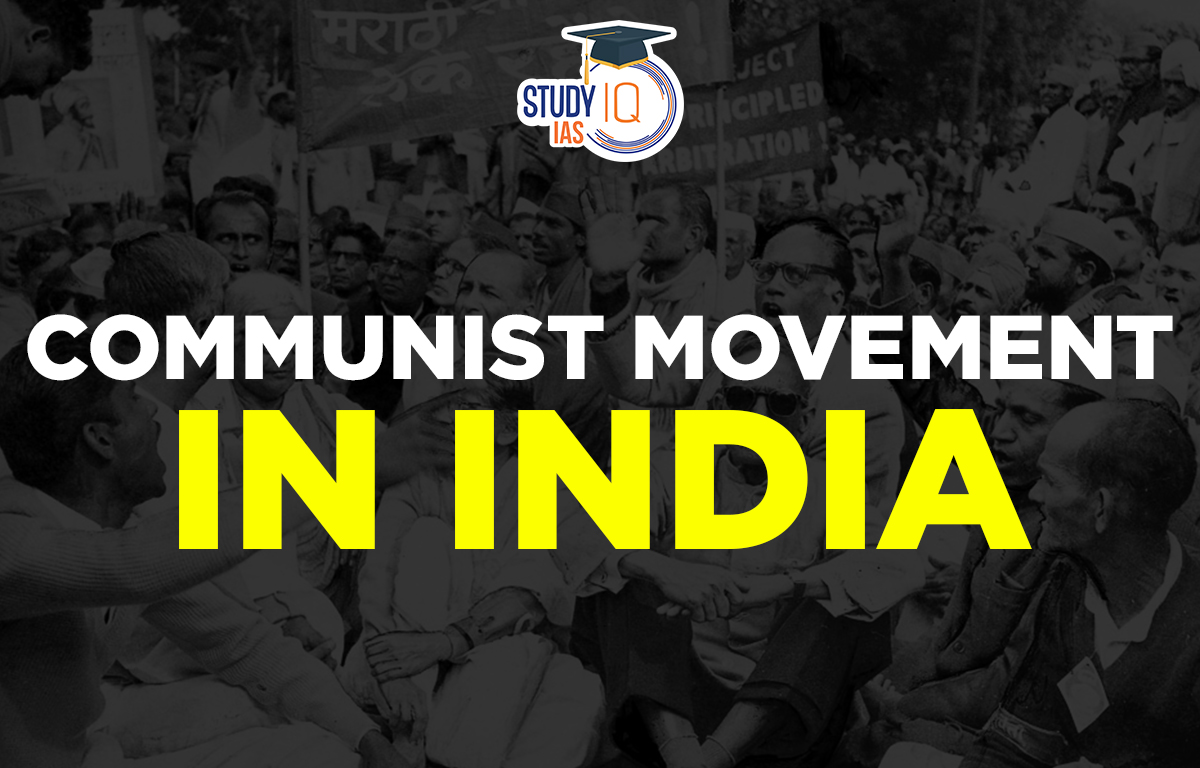Table of Contents
Communist Movement in India
The Communist Movement in India was established following the second Commintern Conference by M.N. Roy, Abani Mukherji, and others. It was established in Tashkent in 1920. (now the capital of Uzbekistan). The first chosen Commintern leader was M.N. Roy. Parties for workers and peasantry proliferated across the nation, disseminating Marxist and communist ideologies.
A significant left-wing organisation in India rose to prominence in the late 1920s and early 1930s, aiding in the hardening of the national movement. Political freedom now placed a stronger emphasis on social and economic issues. This article’s discussion of India’s Communist movement will be helpful for UPSC exam preparation.
Read More: Socio-Religious Reform Movement
Communist Movement in India History
The communist movement in India is said to have been started by Manabendra Nath Roy, formerly known as Narcndra Nath Bhattacharyu. Along with Evelina Trench Roy, Abani Mukhcrji, Rosa Fitingof, Mohammad Ali (Ahmed Hasan), and Mohammad Shafiq Siddiqui, he joined the Second Congress of the Communist International in Russia and Tashkent. On October 17, 1920, he established the emigrant Communist Movement in India.
He had previously been a key figure in the 1919 formation of the Communist Party of Mexico. Roy attempted to strengthen the movement in India while maintaining touch with the Anushilan and Yuguntar groups in Bengal. In Bengal (Jed by Muzaffar Ahmed), Bombay (S. A. Dange), Chennai (Singaravelu Chettiar), United Provinces (Shaukat Usmani), and Punjab, small communist organisations were founded (led by Ghulam Hussain).
The British administrators were alarmed by the new generation of revolutionaries, and on March 17, 1924, charges were brought against M. N. Roy, S. A. Dange, Muzaffar Ahmed, Nalini Gupta, Shaukat Usmani, Singaravelu Chettiar, Ghulam Hussain, and R. C. Sharma for allegedly starting a violent uprising to strip the King Emperor of his authority over the British in India. The Kanpur Communist Conspiracy case was what this was referred to as. However, this government action was a disguised gift for the communists as the mas1 learned about the plans, ideologies, and objectives of Communist International in India.
Read More: Young Bengal Movement
Communist Movement in India Objective
The Communist Movement in India proclaimed that socialism in India would be built through revolution. The party was acknowledged by the Communist International as the Indian branch in 1934. The party started taking a more radical position. Under its new strategic direction, the CPI had given up on nonviolent forms of political action in favour of armed opposition to British imperialism.
In addition to numerous other radical initiatives, the Communist Party required the nationalisation of banks, tea gardens, shipping companies, and zamindari. Along with distancing itself from the Civil Disobedience Movement, it also criticised the Gandhi-Irwin Pact as a treachery of the Indian people in line with the new policy position.
Read More: French Revolution
Communist Movement in India Impact
Kanpur Bolshevik Conspiracy Case
Beginning in British India in 1924, the Kanpur Bolshevik conspiracy case was a controversial legal proceeding. The British government initiated two additional conspiracy cases after Peshawar in 1922, one in Kanpur (1924), and one in Meerut (1925). (1929). The British government, which hated communists, also filed the Kanpur Conspiracy Case against newcomer communists.
Newly converted communists M N Roy, Muzaffar Ahamed, S A Dange, Shukat Usmani, Nalini Gupta, Singaravelu Chettiar, and Ghulam Hussain were arrested and charged with plotting against the government. However, this situation made the communists more well-known.
The topic was thoroughly covered in the newspapers, allowing Indians for the first time to learn in-depth information about communist ideology. As a consequence, this case is to blame for the spread of Communism among Indians. M N Roy was not detained in this case because he was accused in his absence. After working as a British spy, Ghulam Hussain received a pardon. The remaining individuals were all detained and given jail terms of four years.
Indian Communist Conference
M.N. Roy established the Communist Party of India (CPI) in December 1925 after the Indian Communist Conference was convened in Kanpur that year. The early communist organization in India met at the Kanpur Communist Conference, which took place there from December 26 to December 28, 1925. The Kanpur meeting was deemed the party’s founding occasion by the Communist Party of India’s leadership in 1959.
The dialectical fusion of national and class conflicts, which had been profoundly crystallized by the Russian revolution and global events, led to the founding of the Communist Party of India in 1925. All progressive facets of the national movement enthusiastically welcomed it. The culmination of these events was the creation of the CPI in Kanpur in 1925. A close partnership with the freedom struggle was symbolized by the conference’s proximity to Congress Pandal.
The Kanpur Conference created a formal organisation, chose officers for its central executive committee, and approved a red flag, a registration form, and a constitution. CPI changed over time to assume the shape it does today. National and class duties were combined dialectically by CPI. The Kanpur conference chose M. Singaravelu as its chairman and S. V. Ghate and J. P. Bagerhatta as the CPI’s general secretaries. Ghate served as the single general secretary starting in 1927.
Meerut Conspiracy Case
A contentious legal dispute known as the Meerut Conspiracy Case started in the British Empire in March 1929 and was resolved in 1933. The growing influence of the Communist International obviously concerned the British government. It was also utterly persuaded that the Communist Party of India (CPI) was indoctrinating the workforce with socialist and communist ideologies.
In the end, it sought to “completely paralyze and overthrow established governments in every nation (including India) through a general strike and armed uprising,” according to the government. The Meerut Conspiracy Case was immediately brought forth by the government as a reaction. Three Englishmen were among the many trade unionists detained for organizing an Indian train strike.
The British government was sued by 27 left-leaning union officials, who were all found guilty. The trial received instant attention in England, where it served as the inspiration for the Red Megaphones’ 1932 play “Meerut,” which emphasized the detrimental effects of colonization and industrialization.
Read More: Singh Sabha Movement
Communist Movement in India UPSC
Indian politics and culture were significantly impacted by the Communist movement in India. The organization of labourers and peasants, which was covered elsewhere, was one of its greatest successes. Congress was significantly impacted by it. About one-third of the votes cast in the All-India Congress Committee on important issues were influenced by the Communist movement in India. Read all about the Communist movement in India in this article for UPSC Exam preparations.
Read More: Wahabi Movement


 Maharashtra’s Mendrachi Vancharai Syst...
Maharashtra’s Mendrachi Vancharai Syst...
 Keeladi Excavation: Uncovering the Ancie...
Keeladi Excavation: Uncovering the Ancie...
 Sanyasi Revolt, Objectives, History, Rea...
Sanyasi Revolt, Objectives, History, Rea...





















